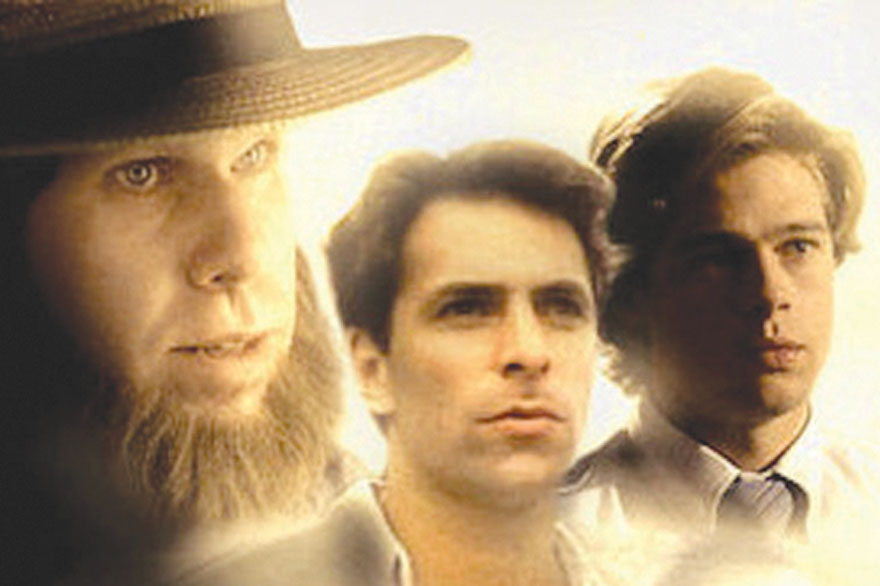The Amish feature in themes and plots in many TV shows, movies, and other forms of media. It is just too easy to create drama, comedy, conflict, etc., based on the culture clash of the Amish vs. the mainstream society around them. One film that does stick out from the dustbin of unrealistic Amish stories is the 1998 NBC made-for-TV movie, “A Stoning in Fulham County.”
It was based on the true story of the death of an Amish baby in Indiana in 1979. The movie opens with some rowdy non-Amish boys from town who, for fun, drive around throwing stones at Amish buggies at night. The activity is called “clape-ing,” coming from a derogatory local term for the Amish — “clape” for clay ape, a term that probably relates to the Amish being farmers. On this particular night, one of the boys from town accidentally hits and kills an Amish baby.
Some boys (including a young Brad Pitt) are rounded up that night, but the Amish father, Jacob Shuler (Ron Perlman), does not wish to cooperate with the police. To make matters worse, the only person who actually saw the boys is his little girl, and Jacob doesn’t want her questioned by the police, much less put on the witness stand in court.
The county prosecutor, Jim Sandler (Ken Olin), is a big city lawyer who has moved to the rural Iowa town with his wife (Jill Eikenberry), hoping to start up a new law practice there. He is filling out a term as County Prosecutor, in the hopes of winning the position in the next election.
Jim is torn about what to do in this difficult situation. He feels the boys must be prosecuted, but the Amish family does not wish to file charges due to their religious convictions, and many in the non-Amish community want to cover things up, or at least downplay the incident as an unfortunate accident. Jim decides to charge the boys with “Reckless Homicide.”
Both fathers wrestle with their consciences and struggle with their personal feelings and the reactions of their family members. When Jim has told the Amish to turn the other cheek, he snaps “Not a bad way to live unless you’re the only ones who do.” Jacob calmly quotes the Bible to Jim, “Vengeance is mine. I will repay, saith the Lord.”
There is a good depiction of an Amish baptism, as the family tries to deal with its loss and Jim tries to get the elders to allow the Amish to testify. The townsfolk remind Jim he is losing clients and possible election by pursuing the case against the local boys. His family is harassed, and his son gets into a fight at school. Both fathers recognize the other is paying a price for his actions.
Without testimony by the Amish, it seems doubtful Jim can succeed, but he takes the case to court because he thinks it is his moral duty. The lawyer for the boys notes there is “hardly a man in the county who didn’t go out clapeing one time or another when they were kids.” Jim states the problem simply as a “lack of concern or caring about the tolerance of people who are different. Those who are not tolerated have shown the most tolerant of all.”
Finally, it is the anguish of Jacob’s little girl, who saw the boys throw the stones, that forces Jacob to go to court. But as they arrive, with reporters and TV cameras everywhere, the boys’ lawyer immediately changes the plea to guilty, knowing the girl can identify his clients. For this reason, the little girl avoids having to testify after all.
In an epilogue, the narrator says that there have not been further incidents since the trial and that Jim was elected as county prosecutor. He also notes that the boys were fined ($2,000 to $5,000) for their crime, and received sentences of 3-5 years, which were suspended.
Despite some minor flaws in the depiction of the Amish, this is a compelling and thought-provoking story, made all the more powerful by the fact that it actually happened. As is the case with most crimes against religious or ethnic minorities, they are often the result of the misunderstanding and dehumanizing of other people simply because they are different. Over the years the media have sometimes helped to reinforce this stereotyping, but movies and television can also open our eyes to these problems in a dramatic way.
— Brad Igou

